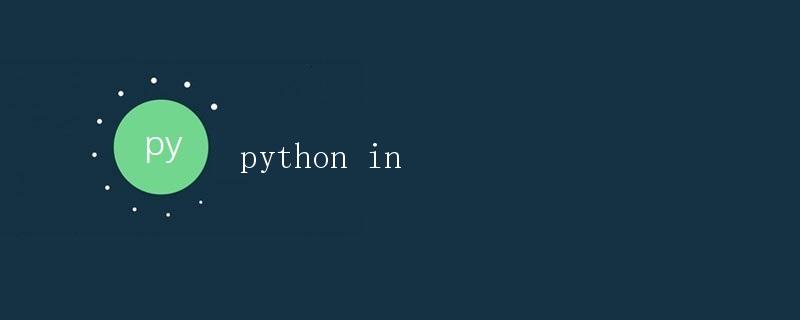Python in

Python是一种高级编程语言,它具有简洁易懂、强大灵活的特点,同时也有着丰富的库和模块可以供开发者使用。在Python中,in关键字是一个非常常用的操作符,用来检查某个值是否存在于某个容器类型中。本文将详细介绍Python中in的用法,包括在字符串、列表、元组、集合和字典中的应用。
在字符串中使用in
在Python中,可以使用in关键字来检查一个字符串是否包含另一个子字符串,示例代码如下:
# 检查子字符串在字符串中
text = "Welcome to geek-docs.com"
if "geek" in text:
print("The substring 'geek' is in the text.")
else:
print("The substring 'geek' is not in the text.")
运行结果:
The substring 'geek' is in the text.
在列表中使用in
在Python中,可以使用in关键字来检查一个元素是否存在于一个列表中,示例代码如下:
# 检查元素是否在列表中
my_list = [1, 2, 3, 4, 5]
if 3 in my_list:
print("The element 3 is in the list.")
else:
print("The element 3 is not in the list.")
运行结果:
The element 3 is in the list.
在元组中使用in
在Python中,可以使用in关键字来检查一个元素是否存在于一个元组中,示例代码如下:
# 检查元素是否在元组中
my_tuple = (1, 2, 3, 4, 5)
if 6 in my_tuple:
print("The element 6 is in the tuple.")
else:
print("The element 6 is not in the tuple.")
运行结果:
The element 6 is not in the tuple.
在集合中使用in
在Python中,可以使用in关键字来检查一个元素是否存在于一个集合中,示例代码如下:
# 检查元素是否在集合中
my_set = {1, 2, 3, 4, 5}
if 4 in my_set:
print("The element 4 is in the set.")
else:
print("The element 4 is not in the set.")
运行结果:
The element 4 is in the set.
在字典中使用in
在Python中,可以使用in关键字来检查一个键是否存在于一个字典中,示例代码如下:
# 检查键是否在字典中
my_dict = {"name": "Alice", "age": 30, "city": "New York"}
if "age" in my_dict:
print("The key 'age' is in the dictionary.")
else:
print("The key 'age' is not in the dictionary.")
运行结果:
The key 'age' is in the dictionary.
通过以上示例代码,我们可以看到在Python中使用in关键字来检查是否包含某个元素在不同类型的数据结构中的灵活应用。在实际编程中,合理地使用in关键字可以提高代码的可读性和效率。
 极客教程
极客教程